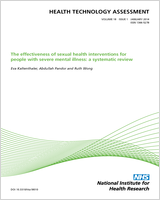Included under terms of UK Non-commercial Government License.
NCBI Bookshelf. A service of the National Library of Medicine, National Institutes of Health.
Simpson EL, Stevenson MD, Scope A, et al. Echocardiography in newly diagnosed atrial fibrillation patients: a systematic review and economic evaluation. Southampton (UK): NIHR Journals Library; 2013 Aug. (Health Technology Assessment, No. 17.36.)

Echocardiography in newly diagnosed atrial fibrillation patients: a systematic review and economic evaluation.
Show detailsDecision problem
The purpose of the assessment was to address the question ‘What is the clinical effectiveness and cost-effectiveness of performing a routine echocardiogram in all newly diagnosed patients with AF in preventing complications arising from AF, in comparison with current practice of selective testing?’
The population was newly diagnosed patients with AF.
Potential subgroups identified prior to the review were those patients in whom AF was diagnosed when they presented with associated medical conditions (heart failure, stroke or thromboembolism), as opposed to patients in whom AF was the primary diagnosis, whether asymptomatic or based on symptoms not requiring hospital visit, or patients receiving diagnoses of paroxysmal, persistent or permanent AF. Lack of data made analyses of these subgroups impractical.
The technology investigated was TTE.
Conventional TTE was the intervention. Included modes were M-mode, 2D/cross-sectional and the Doppler modes (colour flow mapping, continuous wave, pulsed wave).
Complex or invasive modes of TTE were excluded, such as stress/exercise echocardiography, contrast echocardiography, three-dimensional echocardiography and intraoperative echocardiography. These would not form the routine TTE. Invasive modes, such as contrast TTE requiring application of dobutamine or adenosine, would have a different impact on patients and may have adverse effects, unlike routine TTE, as well as differences in time taken and cost.
We excluded diagnostic assessments that used a combination of tests including TTE.
The intervention was defined as TTE in all newly diagnosed patients with AF. This included patients for whom TTE is not currently recommended, such as patients with AF for whom the need to initiate anticoagulation therapy has already been decided on clinical criteria.
The comparator was current practice, that is only selected subgroups of patients with AF undergoing TTE. These comprise:
- younger patients for whom a baseline echocardiogram is important for long-term management
- patients for whom cardioversion (electrical or pharmacological) is being considered
- patients in whom there is a high risk or a suspicion of underlying structural/functional heart disease (such as heart failure or heart murmur) that influences their subsequent management
- patients in need of clinical risk stratification for antithrombotic therapy.
The decision problem was essentially reduced to the cost-effectiveness of TTE in those patients where there would initially be a decision not to provide anticoagulation treatment (that is those patients with a CHADS2 or CHA2 DS2-VASC score of 0). In such a group the use of TTE could detect underlying conditions that are associated with a high risk of stroke and for which the use of anticoagulant treatment would be recommended.
Outcomes sought related to selected pathologies in patients with AF identifiable by TTE. Clinical outcome measures were diagnostic accuracy of TTE in identifying pathologies as measured in terms of sensitivity [proportion of true-positives (TPs)] and specificity [proportion of true-negatives (TNs)] and prognosis of AF populations based on diagnosis of pathology by TTE, and prevalence of these pathologies in AF.
Overall aims and objectives of assessment
The objectives of the review were to:
- investigate, by systematic review, the diagnostic accuracy of TTE for clinically important pathologies in AF
- investigate, by systematic review, the prevalence of these pathologies
- estimate the potential benefits and harms due to altered treatment based on results of TTE
- estimate the incremental cost-effectiveness of routine TTE for newly diagnosed compared with current practice of TTE in selected patients with AF.
- Definition of the decision problem - Echocardiography in newly diagnosed atrial ...Definition of the decision problem - Echocardiography in newly diagnosed atrial fibrillation patients: a systematic review and economic evaluation
- Assessment of factors relevant to the NHS and other parties - Echocardiography i...Assessment of factors relevant to the NHS and other parties - Echocardiography in newly diagnosed atrial fibrillation patients: a systematic review and economic evaluation
- Rapid review results - A cloud-based medical device for predicting cardiac risk ...Rapid review results - A cloud-based medical device for predicting cardiac risk in suspected coronary artery disease: a rapid review and conceptual economic model
- Researchers’ experiences of conducting evaluations of digital technologies for h...Researchers’ experiences of conducting evaluations of digital technologies for home monitoring health conditions - Feasibility of in-home monitoring for people with glaucoma: the I-TRAC mixed-methods study
- yj06f04.s1 Soares placenta Nb2HP Homo sapiens cDNA clone IMAGE:147967 3', mRNA s...yj06f04.s1 Soares placenta Nb2HP Homo sapiens cDNA clone IMAGE:147967 3', mRNA sequencegi|858666|gnl|dbEST|258999|gb|R8206Nucleotide
Your browsing activity is empty.
Activity recording is turned off.
See more...